What are globular star clusters?
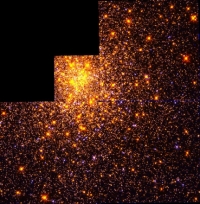 Globular star clusters are dense balls of up to 1-2 million stars which surround most galaxies. Some 147 such clusters have been observed to belong to our Milky Way galaxy. Globular clusters were among the first objects to be formed in the universe. Their smallest, most numerous stars have scarcely changed in the 12 billion years or so since the formation of galaxies, soon after the Big Bang. They are 'fossil relics' of conditions during the early history of our galaxy. Globular star clusters are dense balls of up to 1-2 million stars which surround most galaxies. Some 147 such clusters have been observed to belong to our Milky Way galaxy. Globular clusters were among the first objects to be formed in the universe. Their smallest, most numerous stars have scarcely changed in the 12 billion years or so since the formation of galaxies, soon after the Big Bang. They are 'fossil relics' of conditions during the early history of our galaxy.
For this reason, they can be used to determine a lower limit on the age of the universe. If we measure that the stars in globular clusters are of a certain age, then we know that the universe must be of that age - or older. Knowing the age of the universe helps us to determine its future prospects - something which we and our descendants have a certain stake in!
Clearer vision with the TRIFFID camera from NUI Galway
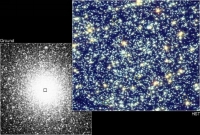 So the biggest telescope is the best for observing clusters, right? Well, no... In astronomy, the 'seeing' means the image sharpness - which is never as good as one hopes, because atmospheric turbulence smears the light out before it reaches the telescope. So the biggest telescope is the best for observing clusters, right? Well, no... In astronomy, the 'seeing' means the image sharpness - which is never as good as one hopes, because atmospheric turbulence smears the light out before it reaches the telescope.
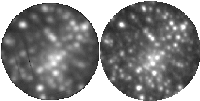 This is why the HST, although smaller than many ground-based telescopes, can resolve much finer detail in the centre of a cluster - because it orbits above the Earth's turbulent atmosphere. At NUI Galway, we work extensively with HST images - we have even developed software to 'deconvolve' still finer detail in them. This is why the HST, although smaller than many ground-based telescopes, can resolve much finer detail in the centre of a cluster - because it orbits above the Earth's turbulent atmosphere. At NUI Galway, we work extensively with HST images - we have even developed software to 'deconvolve' still finer detail in them.
Also, astronomers at NUI Galway have developed the TRIFFID camera to do image sharpening, which can make the 'seeing' twice as good. This is essential in crowded starfields such as globular cluster cores: we cannot study individual stars, unless we can resolve them apart! Basically, sharpening means using a fast 2-D photon-counting camera to store data in a realtime format, and sophisticated software to track the stars, even as they dance about because of the atmospheric turbulence and telescope wobbles, when we later process the data.
Measuring the cluster stars: Crowded-field photometry
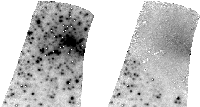 Using sharp digital images of globular clusters, we can measure a great variety of the properties of both individual stars and the cluster as a whole. The key to unlocking this information is the measurement technique known as "crowded-field photometry''. Astronomers in NUI Galway have been to the forefront in pushing this technique to its computational limits on top-end workstations. Using sharp digital images of globular clusters, we can measure a great variety of the properties of both individual stars and the cluster as a whole. The key to unlocking this information is the measurement technique known as "crowded-field photometry''. Astronomers in NUI Galway have been to the forefront in pushing this technique to its computational limits on top-end workstations.
What we learn from the photometry
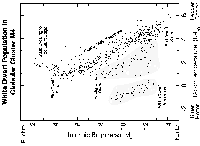 The raw output from crowded-field photometry is the number of detectable stars, their positions, their brightnesses, and what's left behind after digitally subtracting these stars from the image. With images taken through different colour filters we can also measure the stars' colours (surface temperatures), and plot these in a colour-magnitude diagram (CMD).
Theoretical modelling of CMDs gives the age of the stars; the "metallicity'' or chemical makeup of the stars (what proportions of Hydrogen, Helium, Oxygen, Iron etc. they possess); and their distance
(the nearest cluster is M4 at about 2kpc, while one of the most distant is Pal 4 at about 70kpc). This is only possible because all the stars in a given cluster are coeval, are extremely chemically homogeneous, and lie at approximately the same distance from us. These unique properties of Globular Clusters make them the nearest thing to a controlled astrophysical experiment - hence they are 'stellar laboratories in the sky'.
The raw output from crowded-field photometry is the number of detectable stars, their positions, their brightnesses, and what's left behind after digitally subtracting these stars from the image. With images taken through different colour filters we can also measure the stars' colours (surface temperatures), and plot these in a colour-magnitude diagram (CMD).
Theoretical modelling of CMDs gives the age of the stars; the "metallicity'' or chemical makeup of the stars (what proportions of Hydrogen, Helium, Oxygen, Iron etc. they possess); and their distance
(the nearest cluster is M4 at about 2kpc, while one of the most distant is Pal 4 at about 70kpc). This is only possible because all the stars in a given cluster are coeval, are extremely chemically homogeneous, and lie at approximately the same distance from us. These unique properties of Globular Clusters make them the nearest thing to a controlled astrophysical experiment - hence they are 'stellar laboratories in the sky'.
From a set of images taken over a period of time we can additionally measure position changes (astrometric proper motion and parallax) which can tell us exactly which stars are cluster members and their distance.
The importance of variable stars in globular clusters
 From the photometry of several images we can look for those rare stars which show changes in brightness/colour, and determine their periods. This really ties down their stellar population type. Over several years, we can even look for period changes - showing the underlying evolution of the stars before our very eyes! From the photometry of several images we can look for those rare stars which show changes in brightness/colour, and determine their periods. This really ties down their stellar population type. Over several years, we can even look for period changes - showing the underlying evolution of the stars before our very eyes!
Pulsating variables (eg. RR Lyrae stars) especially yield crucial information: the metallicity and distance of the cluster; the effect of dynamical stellar encounters on the evolution of the cluster; and a hugely important step on the distance-scale ladder, which determines the size, rate of expansion, and age of the Universe via Hubble's Law.
NUI Galway astronomers have discovered or confirmed some 25 new RR Lyrae stars in M15, using images from the TRIFFID camera.
|

